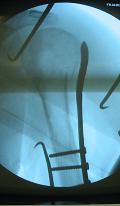- proximal first or screw insertion method - goal is bring frx out to length (anatomically reduced) and to have the plate optimally positioned (not too proximal /not too distal);
- disimpaction:
- longitudinal traction to limb is applied
- periosteal elevator is inserted into the fracture gap to disimpact the fracture;
- elevator is inserted from anteriorly and is directed medially and superiorly;
- biciptal groove is a good initial indicator of reduction;
- need to restore medial butress
- homan retractor can be inserted into the fracture site to lever the fracture out of varus;
- if medial buttressing is insufficient, esp w/ varus malreduction, there may be loss of reduction and subsequent screw perforation or plate breakage;
- ref: Internal fixation of proximal humerus fractures using the locking proximal humerus plate.
- cautions: oblique fractures with shortening can be especially difficult to reduce;
- varus malalignment is unacceptable;
- temporary k wire fixation
- k wires are inserted through the plate holes to achieve temporary reduction;
- k wires can be inserted anteriorly from inferior to superior for temporary fixation;
- indirect suture reduction and suture fixation:
- can be achieved by securing the plate to the head fragment first (especially important for 3 part, and 4 part fracture)
- consider suture fixation at tendon osseous juntion (supraspinatus and infraspinatus) by applying sutures thru cuff and plate (suture holes at top of plate);
- a single running suture may produce the most even distribution of forces across the construct;
- as the plate is translated inferiorly, tension is applied to the suture/plate construct, and the reduction is achieved (frx is moved out of varus);
- plate is then translated inferiorly with maximal force using a homan through one of the distal screw holes;
- this tightens the sutures and strengthens the construct;
- this lowers the plate so that there will not be impingement;
- plate is secured to the shaft with a proximal locking screw to hold the reduction;
- in study by Südkamp N, et al, additional sutures were used to stabilize the greater or lesser tuberosity in the cases of 110 frx (59%)
- references:
- Open reduction and internal fixation of proximal humeral fractures with use of the locking proximal humerus plate. Results of a prospective, multicenter, observational study.
- Transosseous Suture Fixation of Proximal Humeral Fractures (letter to the editor)
- Transosseous Suture Fixation of Proximal Humeral Fractures. Surgical Technique
- Transosseous Suture Fixation of Proximal Humeral Fractures
- Tension Suture Fixation Using 2 Washers for Proximal Humeral Fractures
- Results of proximal humeral locked plating with supplemental suture fixation of rotator cuff.
- [Case-control study on suture-assisted locking plate for the treatment of proximal humeral fractures in elderly].
- proximal screw reduction:
- alternatively insert 1-2 promimal screws (non locking) into the head, which will secure the optimal head position;
- insert non locking screws through the distal screw holes in order to compress the head to contoured plate;
- this will bring the head fragment out of its varus position, and into anatomic alignment;
- references:
- The Biomechanics of Locked Plating for Repairing Proximal Humerus Fractures With or Without Medial Cortical Support.
- The importance of medial support in locked plating of proximal humerus fractures.
- Analysis of efficacy and failure in proximal humerus fractures treated with locking plates

